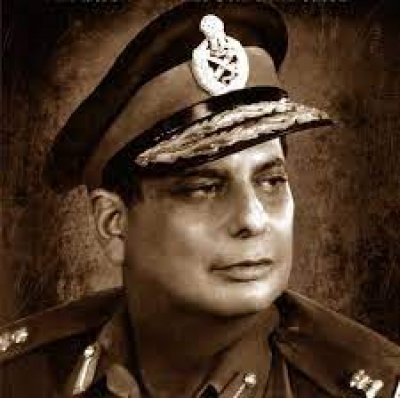By Ian CardozoCalcutta, October 3, 1971
Major General Jack Jacob, Chief of Staff of Headquarters, Eastern Command, popularly known as Jakes, looked up at the huge map that had been tacked to the wall of his bedroom.The map extended from the high ceiling of the bedroom of his old world bungalow in Calcutta right down to the floor.
It was a map of East Pakistan and the bordering Indian states.
On it was marked, all in red, the positions of the Pakistani forces.
In the Indian Army, enemy forces are always marked in red on maps and on sand models, and our own forces are marked in blue, in order to distinguish one from the other.The deployment of Indian forces, however, was not marked on this map, because although General Jacob’s home was secure, it was safer that this information remained unmarked.
(The deployment of Indian forces was subsequently marked on the map for purposes of archival record.)
Detailed information on the two sides was marked in detail on maps pinned to sliding boards in the Operations Room of Eastern Command Headquarters, Calcutta, and was updated every day by duty officers who plotted the latest positions of the opposing forces on the relevant maps.
These maps were covered with transparent talc paper so that the movement of units and formations and their latest positions could be marked, using Chinagraph pencils, in red and blue arrows indicating current movement of opposing forces along with dates.The locations of Pakistani and Indian units were also marked with red and blue pins.
To ensure security of information, the Ops Room was not accessible to anyone without the permission of General Jacob.
Placed in front of the map at his home was an easy chair and beside it were two small tables, one on either side of the chair.
On one was placed dossiers on certain senior officers of the Pakistani armed forces.These dossiers contained detailed information of the Pakistani generals in East Pakistan and also of some senior commanders of the Pakistan Navy and Air Force.
On the other side was a table that had a decanter of Napoleon cognac, a brandy goblet, his favourite pipe and a pouch of Balkan Sobranie tobacco.
General Jacob had been tasked to work out a plan for an offensive into East Pakistan.
He was on a very good equation with General ‘Inder’ Gill, Director of Operations at the MO (Military Operations) Directorate, Army Headquarters, New Delhi, and the two of them knew exactly what had to be done should Pakistan launch its offensive against India, as it had threatened to do.
It was early October 1971, and his task of formulating an offensive plan included the tying up of myriad issues, like updating the details of the riverine terrain of East Pakistan; studying the after-effects of the monsoon on the ground; liaising with the navy and air force, and also with the Mukti Bahini headquarters-in-exile located in Calcutta; working on the movement of engineer stores; creating ammunition dumps; creating space in military and civil hospitals in anticipation of heavy casualties; deciding where workshop facilities should be positioned; liaising with civil aviation for possible contingencies; moving forward the supplies of ammunition, food and other necessities that would be required in the event of a war.
All these activities had kept him extremely busy.
He would return home late in the evening and after a light dinner, sit in his bedroom and look at this huge map.A glass of cognac helped him unwind after a strenuous day, and the smoke from his favourite pipe stimulated his senses.
The dossiers on his opponents gave him an insight into their minds; their qualifications in terms of military courses and past postings helped him to understand their background.
He worked out in his mind what each enemy commander would do in situations that he himself would create.
Topmost of the dossiers was the one on Lieutenant General A.A.K.Niazi, General Officer Commanding-in-Chief of all forces in East Pakistan.There were also dossiers on General Yahya Khan, the Army Chief of Pakistan; Vice Admiral Muzaffar Hassan, Pakistani Naval Chief; Major General Rao Farman Ali, Military Adviser to the Governor of East Pakistan; Lieutenant General Tikka Khan, Martial Law Administrator, East Pakistan; Rear Admiral Mohammad Sharif, Pakistani Flag Officer Commanding-in-Chief (FOC-in-C), East Pakistan, and some others.
A few months earlier, Pakistan had cobbled up an alliance with the United States of America and China, and the balance of power in the subcontinent had shifted clearly towards Pakistan.In order to checkmate this malevolent triumvirate, the Indian Prime Minister entered into a Treaty of Friendship with Russia, an alliance that stood India in good stead before and during the war.
Richard Nixon, for some reason, had a pathological hatred for India and Prime Minister Indira Gandhi.Perhaps it was because the Indian Prime Minister refused to toe the American line.
Nixon used to refer to the Indian Prime Minister as “that woman” and other epithets that are not worth repeating.Nixon and his Secretary of State, Henry Kissinger, were up to all types of stratagems to help Pakistan in its conflict with India.
Developments on this front also had to be taken cognizance of and monitored.By early October 1971, Indian intelligence was piecing together information concerning Pakistani plans for a war that appeared imminent.
It was already known that Pakistan’s state-of-the-art Daphne-class submarines were, at that time, the best in the world.What was not known was how and when she intended to use these deadly underwater weapons of war.Due to the advantage that the Pakistan Navy had in its underwater capability, it became increasingly important for India to know the plans of the Pakistan Navy, in particular as to how it would deploy its submarines.(Excerpted from ‘1971: Stories of Grit and Glory from the Indo-Pak War’ with the permission of the publisher, Penguin)ian/vm/srb
Dossiers that helped Maj Gen JFR Jacob chalk out his strategy (Book Extract)
Richard Nixon had an irrational hatred of India and Prime Minister Indira Singh.It could have been because the Indian Prime minister refused to follow the American line.Nixon used to call the Indian Prime Minister “that woman”, and many other insults not worthy of repeating.
Nixon and Henry Kissinger, his Secretary of State were open to any kind of strategy to aid Pakistan’s conflict with India.This front was also important to monitor and take note of. In October 1971, Indian intelligence began to gather information about Pakistani plans and strategies for war.At that point, it was well-known that Pakistan’s Daphne-class, state-of the-art submarines were the most advanced in the world.It was unknown when and how she planned to use the deadly submarine weapons of war.
India was able to benefit from the Pakistan Navy’s underwater capabilities and it became more important to understand the plans of Pakistan Navy.
(Excerpted with permission from Penguin from “1971: Stories of Grit and Glory From the Indo-Pak War”
#Jacobs #strategy #aided #Dossiers #Extract #Delhi #Napoleon # Napoleon #Ali #China #Bungalow #Delhi #New Delhi #Hassan #Russia #America
.






